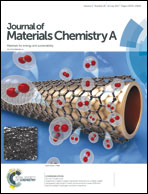Poly(p-phenylene terephthamide) embedded in a polysulfone as the substrate for improving compaction resistance and adhesion of a thin film composite polyamide membrane†
Abstract
A new approach to improving the compaction resistance and polyamide skin layer adhesion onto the substrate in thin film composite (TFC) membranes was developed. It was based on in situ polymerization of p-phenylene terephthamide (PPTA) in a polysulfone (PSf) solution prior to membrane casting via the phase inversion process, thereby forming a PPTA-embedded PSf substrate. The TFC membrane was prepared by interfacial polymerization on such (PPTA/PSf) substrates. The crystal structure of the PPTA polymerized in the PSf/NMP solution was investigated by XRD and TEM. The immobilization of PPTA in the PSf substrate was confirmed by FTIR and XPS. The surface properties of the PPTA/PSf substrates were characterized by FESEM, AFM and WCA measurements. Incorporating PPTA into the substrates resulted in more open porous structures and a thinner dense layer, as well as a rougher and more hydrophilic surface. Both the compaction resistance of the TFC membrane and the polyamide skin layer adhesion onto the substrates were improved by the presence of PPTA. The TFC membranes exhibited a typical nanofiltration performance with salt rejections in the order of Na2SO4 > MgSO4 > MgCl2 > NaCl.



 Please wait while we load your content...
Please wait while we load your content...